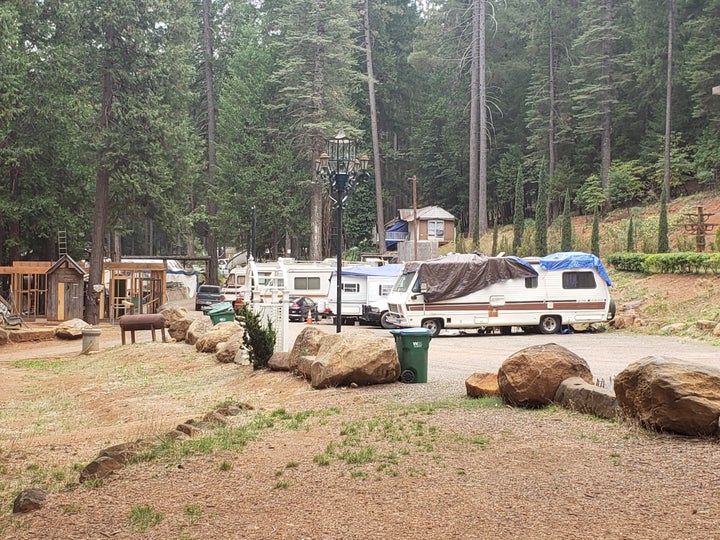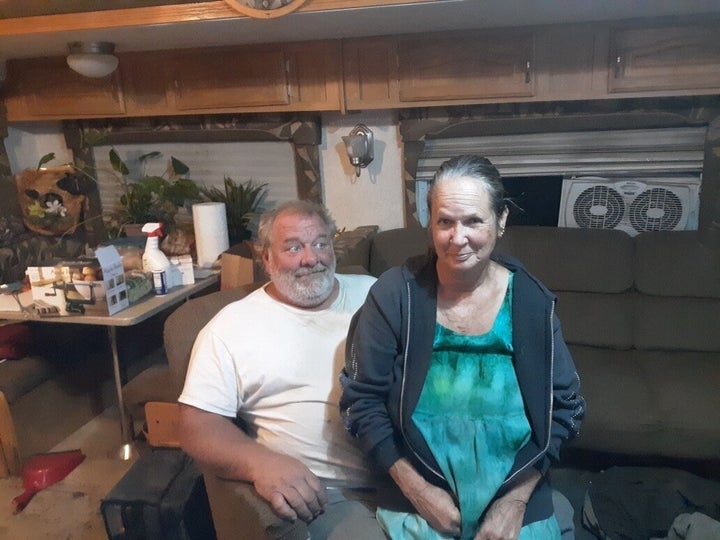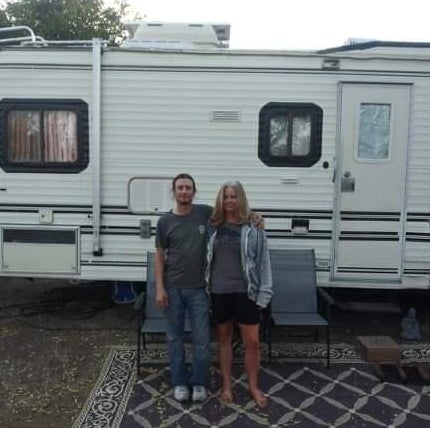Kim Coulon lived in a “cute little apartment” in the town of Paradise, California, with her 16-year-old son. Then on the morning of Nov. 8, 2018, everything changed. In the span of a few hours, the deadly Camp fire blazed across the mountain ridge and burned nearly the whole town to the ground.
“It was like a little treehouse to me,” Coulon said of her rental. “It disintegrated.”
Now a year later, she’s living with her son and her boyfriend in a 24-foot RV in a co-worker’s driveway. They’ve been stuck there in Durham, a town not far from Paradise, since July. Before that, they were in another co-worker’s driveway in nearby Chico.
“I feel like I’m in a coffin,” Coulon said of the RV last month. She didn’t have renter’s insurance so she doesn’t have enough to afford another place in the area. Butte County already had a low housing vacancy rate ― around 1%-2% ― and that was before more than 18,000 homes burned.
“I can only stay here through November and then what am I gonna do?” Coulon asked. “Am I gonna be parking this [RV] as a homeless person?”
The Camp fire, which killed 85 people in Northern California, torched nearly 90% of the rural community of Paradise. For months afterward, survivors were sleeping on friends’ couches, doubled up in homes, squeezed into trailers or other vehicles. Some were in homeless shelters.
Today, the town itself shows signs of a steady recovery. The cleanup of miles of ashes and charred debris is largely complete. Over 200 building permits have been issued, according to Mayor Jody Jones. Even so, only an estimated 5,000 people are living there now, down from a population of over 26,000 before the fire. Many are housed in trailers on their property, waiting to rebuild.
As for those who didn’t have insurance or were renting and don’t have property to rebuild on, many are scattered around the region, still struggling to find a permanent home a year later.
“I feel like the people that had a support system, insurance, and were living relatively comfortably are starting to resolve some issues,” said Siana Sonoquie, who runs a winter shelter for homeless residents in Chico. “It’s the people that didn’t have that, who were living in substandard housing or didn’t have housing insurance,” who still don’t have good options.
“You see the stark difference between the haves and the have nots,” she added. “It’s who gets left behind.”
Paradise was a lower-income community, with a median household income of $49,000 (well below the national median), and a quarter of its residents were over 65. Like many regions of California, Butte County had a serious homelessness problem even before the fire. As of March of this year, the number of homeless residents had risen by 16% compared to 2017.
Coulon said rental prices in the area are too high now for what she makes as an education assistant at a high school working with students with special needs. She’s been on leave since September for depression and anxiety, which she attributes to the fire and its aftermath.
“I’ll never be able to rent in this county again,” she said. “I had a life. I created this little life. ... It was a humble little life. And I can’t get it back. ... I can’t get the same feeling living in this RV.”
“I feel like I’m gonna be living in this RV for the rest of my life,” she said. “It took everything.”

On a property that local residents call Nimshew Park in the town of Magalia, which was hit hard by the Camp fire, Kris Nikolauson has created a makeshift community of fire survivors. There are more than a dozen trailers and motor homes, one tent and soon a tiny house on the land, with about 30 residents paying $10 a day or $300 a month to park there.
“They live in whatever they can to keep a roof over their head,” Nikolauson said.
At the Torres homeless shelter in Chico ― a college town where rental prices run far higher than around Paradise ― the 160 or so beds have often been filled to capacity since the fire, according to Joy Amaro, who heads the shelter. They added about 25 beds for families after the fire, she said, and those spots filled immediately, with a waiting list of hopefuls. Not all of the latest residents were direct victims of the fire — some were pushed out of housing as prices rose after the blaze.
Before the blaze, the average stay at the shelter was about 55 nights. Now it’s around 80 nights. The waiting lists to transition people into lower-income housing are hundreds of people long.
“It’s still dire,” Amaro said of the housing situation a year out. “It’s all around us, the housing crisis.”
“People feel like the fire is still burning. Some people wish they’d just laid in the fire and ended it there.”
- Kim Coulon, a Camp fire survivor
Therese Rubiolo, 60, knows all too well how bad the housing situation has been. She and her husband John spent the past three years feeding homeless people six days a week out of their home in Concow. They had a big kitchen with three stoves, three fridges, three freezers, an island. Then their house ― and much of Concow ― burned down in the Camp fire, and they became homeless, too.
The Rubiolos were soon able to get back on their property, but this time they were living in a trailer, with only a small propane stove and a sink. That didn’t stop them from continuing to feed 50 or so people six days a week while trying to pull together the funds to rebuild. Recently they were gifted with a second trailer outfitted as a kitchen to help them continue their work with a bit more space.
The couple had fire insurance, but after spending what they needed to cover the mortgage, they were left with about $130,000. They’ve estimated the cost to rebuild, including permits and other expenses, will be about twice that, around $250,000 to $300,000.
“So we were kind of screwed from the get-go,” Rubiolo said. Living in the trailer has been tough. They’re using a generator for power and a well for water. They can barely walk around the place, climbing in and out on one side of the bed as boxes of clothes are piled around the other sides.
“We fight a whole lot more than we used to. He’s always grumpy,” Rubiolo said. Her husband has a degenerative bone disease that causes him a lot of pain. “It’s hard for him on top of everything else, losing everything and being stuck in a small place.”

As the one-year anniversary of the fire approached, Marylisa Wood ― who operates a monthly, volunteer-run, free medical clinic in the area called Medspire ― could see patients struggling more, their symptoms of post-traumatic stress disorder appearing to grow stronger.
Wood ― who is not a nurse, but whose volunteer team consists mostly of nurses ― grew up in Paradise. They started the clinic after the fire, doing four-hour pop-up services for 30 to 45 patients once a month in areas affected by the blaze. The nurses have seen multiple symptoms associated with trauma, Wood said. Many people come in saying they haven’t been sleeping or have had trouble breathing. Their blood pressure is high.
“Some people come up and are crying and don’t know how to explain and want somebody to just sit there with them,” Wood said.
Coulon, who was taking time off work for her mental health, said she has felt exhausted ever since the fire.
“I’m crying all the time,” she said, adding that she has been suicidal. The psychologist she had before the fire left and has not returned, like many other residents who were displaced.
“I’m depressed, my anxiety is through the roof, I have PTSD,” she said. “It’s far from over. People feel like the fire is still burning. Some people wish they’d just laid in the fire and ended it there.”
The Federal Emergency Management Agency gave Coulon about $2,800 for her rental losses as well as a small business loan with which she bought the RV. The rest of that loan, which she still has to pay back, has almost entirely been spent “just living,” as she put it.
FEMA said it gave an average of $7,415 in housing assistance and $6,605 in other aid to around 8,000 “eligible” households after the Camp fire. But more than 18,000 homes in the area burned. The agency did not provide any comment when HuffPost asked about the discrepancy.

Even those who consider themselves “lucky” are still just starting over a year later.
Kim and Blair, who are in their 50s, lost their home in the Paradise fire (they asked that their last names not be used, citing concerns about possible identity theft) and they’ve been living in a hotel room in Sacramento since, paid for by their insurance. They spent months looking for a place they could afford and didn’t find anything in Butte County. They finally found a house in Dorris, on the Oregon border, and are hoping to move soon. It’s a 4.5-hour drive north, much farther than Paradise was from their kids, who live in Sacramento and Chico.
“We’re the lucky ones, but it’s been hell,” Kim said. Blair, who has diabetes, has had a hard time regulating his blood sugar levels living in a room without a kitchen. He has been hospitalized twice since the fire. And now he’ll be leaving the region he called home for 22 years.
Kim said she’s relieved in some ways that they won’t be living in “a wildfire county,” as she put it. “The first thing I did on this property was call and check it’s not in a wildfire zone,” she said.
“I go through periods where I feel I should not have lived, and I wish I had died in the fire,” Kim said. “But I won’t give PG&E the satisfaction.”
Officials found that the Camp fire was caused by PG&E’s power lines ― one of several fires in the state that the utility has been linked to.
One of the biggest issues the town of Paradise faces now is the thousands of burned trees that are still standing but threatening to fall ― potentially injuring or killing people or wrecking new homes ― if high enough winds blow through. There are about 300,000 such trees in the town, according to the mayor, and about 80,000 hover over properties where people want to build new houses. The town is working on how to get these removed, a pricey and painstaking project.
Meanwhile the town’s water, which was found to be contaminated and undrinkable after the fire, still should not be consumed. A Paradise Irrigation District advisory tells residents to stick to bottled water.
Mayor Jones insisted that the main water lines were largely not affected and they have a “good plan” for the contaminated service lines. They’re testing and, if needed, replacing the lines, first to standing homes and then to new houses as they get built.
“We’re moving forward. We’re resilient, we’re persevering,” the mayor said. “There’s a lot of hope for our future.”
Other survivors struck a considerably less optimistic tone.
“I think people are forgotten,” Coulon said. “It’s not done, it’s far from over. And we’re out here and we still need help.”
If it matters to you, it matters to us. Support HuffPost’s journalism here.
If you or someone you know needs help, call 1-800-273-8255 for the National Suicide Prevention Lifeline. You can also text HOME to 741-741 for free, 24-hour support from the Crisis Text Line. Outside the U.S., please visit the International Association for Suicide Prevention for a database of resources.
